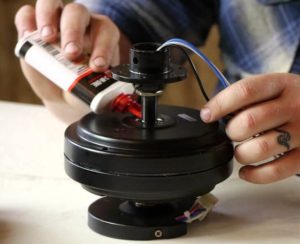You may want to consider running your ceiling fan while keeping the room’s windows open in order to cool it down. However, I have found out that several factors, including the direction in which the fan turns, can influence the effectiveness of this method.
By understanding the correct direction for your fan when using it with an open window, you can maximize the advantages of the cooler outdoor air.
For optimal air circulation, central ceiling fans should spin counterclockwise. This direction helps in pulling air through the window and circulating it effectively. Fans located near open windows should spin clockwise. This prevents the downward airflow from hindering the entry of outside air. In cases where fans are situated far from open windows, they should spin counterclockwise at high speed. This creates a powerful suction effect, drawing air in from the window
Counterclockwise Rotation for Best Effects
Counterclockwise is typically the optimal direction for a ceiling fan when used alongside an open window for cooling purposes.
However, there are exceptions that depend on various factors, including the fan’s location relative to the open window. In the following sections, we will explore these exceptions. For now, let’s assume the fan is positioned in the center of the room.
Although a ceiling fan is highly effective at circulating air, it cannot physically lower the room’s temperature. On the other hand, opening a window can help decrease the ambient temperature, given that the outside air is cooler than the air inside the room. Subsequently, the fan can then circulate this cooler air, enhancing the overall cooling effect.
In addition to circulating the cool outdoor air that enters the room, the ceiling fan generates wind chill, regardless of whether you are sweating, and evaporative cooling, if you are sweating. These two mechanisms work together to make you feel cooler as the air blows over you.
When the ceiling fan spins counterclockwise, it pushes air downwards and displaces air upwards at the sides of the room. In a cyclical pattern, the air on the room’s sides is simultaneously drawn upwards and directed towards the ceiling as the air around the fan is pushed downwards. This movement also pulls in air from outside.
This process ensures effective air circulation throughout the room.
As the air circulates within the room, the air entering through the open window is drawn up towards the fan and becomes the air surrounding the fan, which is then forced downwards into the room. This continuous stream of cooler outside air dilutes the warmer air inside the room, resulting in a cooling effect.
Fan Next to Window Impedes Airflow Efficiency
When a ceiling fan is positioned close to a window and rotates counterclockwise, it can impede the efficiency of airflow entering through the window.
This is due to the downward airflow created by the fan, which can act like an air curtain and even blow some air out through the window, hindering the airflow into the room. Consequently, the air farthest from the window, which is in most need of circulation, receives the least amount of movement.
In such cases, it may be helpful to experiment with the fan’s clockwise rotation, also known as the winter mode. In this mode, the air is drawn upwards instead of being pushed downwards, and the flow is generally less concentrated. The gentler upward movement of air allows it to flow through the window and be caught up in the fan’s airflow, effectively lowering the ambient temperature in the room.
However, it’s important to note that using the fan in a clockwise rotation will result in less airflow on the other side of the room, as the airflow is milder. Additionally, you will not experience the wind chill effect typically provided by the fan.
If you intend to effectively cool your room by utilizing both the ceiling fan and open windows, it is advisable to consider relocating the fan if it is positioned too close to the window.
Fan Too Far From Window Is Also Less Effective
In larger rooms where the ceiling fan is positioned far from the window, the effectiveness of operating the fan while the window is open will be limited.
When only one fan is installed in a large room (in some cases, multiple fans may be necessary for larger or longer rooms), the airflow will primarily be concentrated in the area directly beneath and around the fan. As a result, the enhanced air circulation may not reach the window, limiting the overall benefit of the fan in cooling the room.
While air can still enter the room passively from outside and move within the range of the fan’s circulation zone, it is unlikely that the fan will actively draw air in from outside through the open window. As a result, one part of the room may benefit from the fan’s airflow, while the other part benefits from the open window, but the advantages of both are not fully obtained.
If you have this setup in a larger room, running the fan counterclockwise at a high-speed setting would provide the best chance of drawing at least some of the cooler air into the areas farthest from the window.


